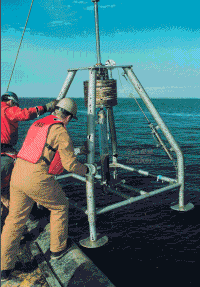Methods
The ongoing fieldwork and navigational support from 1989 to present has been carried out utilizing United States Coast Guard vessels from group Boston. Stations #2 and #3 were revisited three times per year and up to four cores collected from each site. From 1989 to 1992 navigation was based on multiple sextant angles with an estimated accuracy of ±50 m. In 1993, navigation by the Differential Global Positioning System (DGPS) was routinely available with accuracy of ±5 m. In April 1998, the Coast Guard Cutter WHITE HEATH was replaced by the Cutter MARCUS HANNA, which has dynamic positioning capability controlled by DGPS. With this system, cores can be collected with a better than 3 m precision if desired. In practice, cores are taken at random positions within a radius of about 20 m from the target position in order to minimize the chance of repeat sampling at precisely the same location.
 |
| Figure 3. The USGS hydraulically damped gravity corer used to recover sediment in Massachusetts Bay. |
The sediments were collected with a hydraulically damped gravity corer (Bothner and others, 1997; 1998) as shown in Figure 3. Once the coring system is gently placed on the bottom using the ship's winch, the 840-pound core head weight slowly forces the core tube into the sediment. The slow penetration is controlled by a preset water-filled piston. This slows and eliminates the bow wave caused by other types of fast-penetrating samplers (grab samplers and piston corers), and the surficial sediment is minimally disturbed. A "live feed" video camera is also attached to the corer, in order to view the bottom type and to assess any disturbance during the coring process.
In the laboratory, a plastic piston is inserted in the bottom of the core barrel and the core is secured vertically in a frame. The sediment is extruded upward in a controlled manner by the use of a "long throw" hydraulic jack, which pushes against the bottom of the piston. As the sediment is extruded, the outer rim of material in contact with the barrel is trimmed and discarded. The thickness of the core slices varies from 0.5 cm near the surface to 2 cm for depths greater than 10 cm. The grain size samples are stored in a laboratory refrigerator until analysis.
The samples collected for grain-size analysis were processed according to a modified procedure from Anderson and others (1981) and is outlined on a flow sheet in Appendix 1. Analysis objectives were to preserve the biological components of the sediment, to optically identify the kinds of materials present, and to carry out routine grain size analyses. Each sample was gently wet sieved through 2-mm (-1 phi) and 0.0625-mm (4-phi) nested sieves using filtered seawater. The wash containing the fine fraction (silts and clays) was stored in a mason jar for analysis of the size distribution using a Coulter Counter. The coarse fraction retained on the 2-mm sieve was dried and analyzed for gravel distribution. The sediment caught on the 4-phi sieve was gently re-sieved through 0.25-mm (2-phi) and 0.0625-mm (4-phi) sieve. The sediment retained on these sieves includes biogenically-aggregated fines and both inorganic and organic detritus. A visual description and estimation of the aggregates using point count methods was accomplished using a light microscope under reflected light.
The sediment and aggregates were transferred from the sieves to a beaker and sonified in a water bath for 30 minutes to disaggregate fecal pellets and other organic aggregates (Anderson, 1981). The contents of the beaker were then passed through a 4 phi sieve and the wash retained in an underlying beaker. The amount of material finer than 4 phi generated during the sonification step was determined by filtering a known volume of the wash suspension using a pre-weighted Nucleopore filter and determining net weight after distilled water rinsing and air drying. Calculating the total solids weight in the wash provide an estimate of the operationally defined weight of organic-mineral aggregates in the sample.
The fraction (mostly sand) retained on the 4-phi sieve is reintroduced through nested sieves (whole phi intervals), and the weight percentage of each size fraction was determined.
The fines (silts and clays) collected in the mason jar were resuspended and a representative aliquot of solution filtered onto a pre-weighed Nucleopore filter. This was normalized and resulted in the weight of the fine fraction. The remaining fine fraction in the mason jar was analyzed on a Coulter Counter according to standard USGS laboratory techniques (Poppe and others, 2000).
The grain-size distribution of the sieved coarse sediment and the fines were processed through USGS sediment-laboratory computer programs. The complete grain-size distribution was reported for each sample, as calculated using the method of moments grain-size statistical analysis, and output on hard copy and on disc (Poppe and others, 2000).
A sample of well-mixed standard sediment was run with each suite of samples analyzed for grain size in order to monitor laboratory accuracy and precision. The standard is a silty sand collected on the New England Continental Shelf south of Martha's Vineyard. Results of the analyses of 16 standard sediment samples throughout the study varied within a narrow range. The sand content averaged 6.5% ± 0.5 %. The mud content (silt plus clay) averaged 93.5% ± 0.5%.